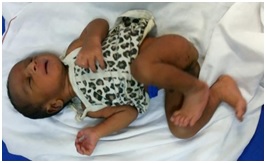Usefulness of ‘Babkin Reflex’ in normal term Indian infants
Abstract
Background: The Babkin Reflex belongs to the group of rarely defined and used primitive reflexes, being easily elicited in normal newborns during wakeful state particularly before feeding. To the best of our knowledge there have been no studies in India about the validity and usefulness of this reflex.
Aim: The purpose of this study was to observe the consistency in duration of appearance and disappearance of the reflex in normal Term infants.
Settings and Design: Hospital based, prospective, observational, longitudinal, single ethnicity study.
Method: A prospective observational study was conducted to study the Babkin reflex in two thousand normal infants and also analyzed the average time of disappearance of the reflex. Descriptive statistics with rate were used.
Results and Conclusion: In normal term infants, the Babkin reflex can be elicited from the time of birth, becomes increasingly suppressed with age, and disappears in the great majority by the end of the fifth month of age. Babkin reflex is surprisingly a fairly consistent primitive reflex which can be used as a screening reflex in all infants. Persistence of this reflex beyond 5 months of age mandates frequent neurological assessment.
Downloads
References
2. Sheppard JJ, Mysak ED. Ontogeny of infantile oral reflexes and emerging chewing. Child Dev. 1984 Jun;55(3):831-43.[pubmed]
3. Pedroso FS, Rotta NT. From the foot-mouth reflex to the hand-mouth reflex. A continuum of responses to appendicular compression. ArqNeuropsiquiatr. 1997 Jun;55(2):186-92.[pubmed]
4. Owen G, Mulley GP. The palmomental reflex: a useful clinical sign? J NeurolNeurosurg Psychiatry. 2002 Aug;73(2):113-5. DOI:10.1136/jnnp.73.2.113.[pubmed]
5. Futagi Y. The Babkin reflex in infants. 2016;(January 1999).
6. Futagi Y, Abe J, Tanaka J, et al. [The diagnostic value of the Babkin reflex]. No ToHattatsu. 1987 Sep;19(5):392-6.[pubmed]
7. Pedroso FS, Rotta NT. Babkin Reflex and Other Motor Responses to Appendicular Compression Stimulus of the Newborn. J Child Neurol 2004 Aug 1;19(8):592–6. Available from: https://doi.org/10.1177/088307380401900805.
8. SK M, NK A, L S, P S, EA A. Neurosensorimotor Reflex Integration for Autism: a New Therapy Modality Paradigm. J PediatrNeurolDisord. 2017;02(01).
9. Blasco PA. Primitive Reflexes: Their Contribution to the Early Detection of Cerebral Palsy. Clin Pediatr (Phila) [Internet]. 1994 Jul 1;33(7):388–97. Available from: https://doi.org/10.1177/000992289403300703
10. Futagi Y, Tagawa T, Otani K. Primitive reflex profiles in infants: differences based on categories of neurological abnormality. Brain Dev. 1992 Sep;14(5):294-8.[pubmed]

Copyright (c) 2019 Author (s). Published by Siddharth Health Research and Social Welfare Society

This work is licensed under a Creative Commons Attribution 4.0 International License.


 OAI - Open Archives Initiative
OAI - Open Archives Initiative


